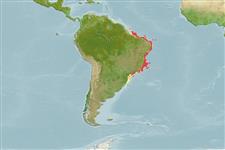>
Tetraodontiformes (Puffers and filefishes) >
Tetraodontidae (Puffers) > Canthigasterinae
Etymology: Canthigaster: Greek, kanthos = the outer or inner corner of the eye, where the lids meet, 1646 + Greek, gaster = stomach (Ref. 45335); figueiredoi: Named in honor of José Lima de Figueiredo, for his contributions to the advancement of the taxonomy of Brazilian marine fishes, as well as for his long term encouragement and support to the authors (Ref. 43205).
Environment: milieu / climate zone / depth range / distribution range
Écologie
marin récifal; profondeur 1 - 70 m (Ref. 43205). Tropical; 9°N - 33°S
Western Atlantic: southern Caribbean to Santa Catarina, Brazil, including the oceanic islands of Atol das Rocas and Fernando de Noronha.
Taille / Poids / Âge
Maturity: Lm ? range ? - ? cm
Max length : 12.0 cm NG mâle / non sexé; (Ref. 42064)
Épines dorsales (Total): 0; Rayons mous dorsaux (Total): 9-10; Épines anales 0; Rayons mous anaux: 9. Differs from other Atlantic Canthigaster species by the long anterior extension of the lower horizontal dark stripe on the flank (composed of irregular horizontal and diagonal bars and originating as a solid stripe on the ventral caudal fin margin). This stripe reaches the pectoral fin base. Differs from C. jamestyleri by the presence of a dark caudal-fin margin, the absence of vertically oriented bars on the caudal fin, the possession of fewer stripes and spots on body especially on the dorsum, as well as by the absence of a small black irregular spot on the anal fin base (Ref. 43205).
Inhabits coral-rich as well as coral-poor areas, and areas with rocky bottoms (Ref. 43205). Maximum depth from Ref. 126840. Often in pairs, hovering over the reef during the day (Ref. 43205). Feeds on vegetation, sponges, crustaceans, and mollusks (Ref. 42064).
Life cycle and mating behavior
Maturité | Reproduction | Frai | Œufs | Fécondité | Larves
Moura, R.L. and R.M.C. Castro, 2002. Revision of Atlantic sharpnose pufferfishes (Tetraodontiformes: Tetraodontidae: Canthigaster), with description of three new species. Proc. Biol. Soc. Wash. 115(1):32-50. (Ref. 43205)
Statut dans la liste rouge de l'IUCN (Ref. 130435)
Menace pour l'homme
Harmless
Utilisations par l'homme
Aquarium: Commercial
Plus d'informations
Taille/ÂgeCroissanceLongueur-poidsLongueur-longueurFréquences de longueursMorphométrieMorphologieLarvesDynamique des populations larvairesRecrutementAbondanceBRUVS
RéférencesAquacultureProfil d'aquacultureSouchesGénétiqueElectrophoresesHéritabilitéPathologiesTraitementNutrientsMass conversion
CollaborateursImagesStamps, Coins Misc.SonsCiguateraVitesseType de nageSurface branchialeOtolithesCerveauxVision
Outils
Articles particuliers
Télécharger en XML
Sources Internet
Estimates based on models
Preferred temperature (Ref.
123201): 23.4 - 27.6, mean 27 °C (based on 177 cells).
Phylogenetic diversity index (Ref.
82804): PD
50 = 0.5000 [Uniqueness, from 0.5 = low to 2.0 = high].
Bayesian length-weight: a=0.03631 (0.01554 - 0.08482), b=2.88 (2.69 - 3.07), in cm total length, based on LWR estimates for this Genus-body shape (Ref.
93245).
Niveau trophique (Ref.
69278): 3.1 ±0.36 se; based on food items.
Résilience (Ref.
120179): Haut, temps minimum de doublement de population inférieur à 15 mois (Preliminary K or Fecundity.).
Fishing Vulnerability (Ref.
59153): Low vulnerability (10 of 100).
Nutrients (Ref.
124155): Calcium = 107 [49, 256] mg/100g; Iron = 1 [0, 2] mg/100g; Protein = 18.1 [15.9, 20.3] %; Omega3 = 0.127 [0.061, 0.255] g/100g; Selenium = 35.6 [16.9, 79.5] μg/100g; VitaminA = 49.6 [13.6, 189.5] μg/100g; Zinc = 1.69 [1.08, 2.55] mg/100g (wet weight);
